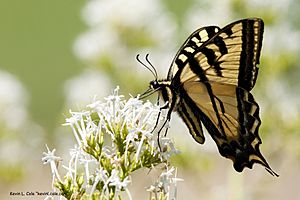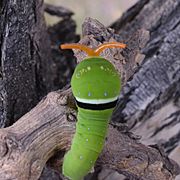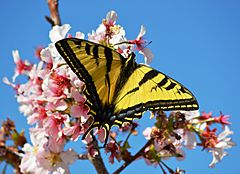Western tiger swallowtail facts for kids
Quick facts for kids Western tiger swallowtail |
|
|---|---|
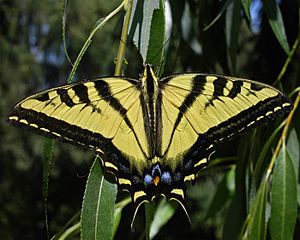 |
|
| Papilio rutulus. Dorsal view | |
| Scientific classification | |
| Genus: |
Papilio
|
| Species: |
rutulus
|
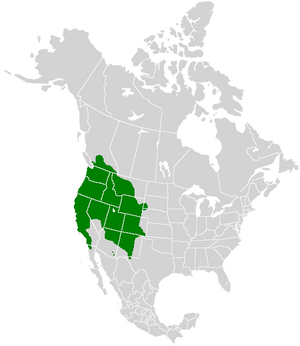 |
|
The western tiger swallowtail (scientific name: Papilio rutulus) is a beautiful butterfly. It belongs to a group of butterflies called swallowtails. These butterflies are known for their "tails" on their hindwings. The western tiger swallowtail is part of the Papilio family, which includes other well-known butterflies like the Appalachian tiger swallowtail and the Asian swallowtail. A scientist named Hippolyte Lucas first described this species in 1852.
Contents
Where Western Tiger Swallowtails Live
This common butterfly lives in many parts of western North America. You can find them from British Columbia in Canada all the way down to Baja California in Mexico. Their range also stretches from North Dakota to New Mexico in the United States. Sometimes, you might see them a bit further east. However, in eastern North America, a very similar butterfly called the Eastern tiger swallowtail usually takes its place.
What Kind of Places Do They Like?
Western tiger swallowtails love to fly around in different places. You often see them in city parks and gardens. They also enjoy living in natural areas like woodlands and along rivers or streams.
What Does a Western Tiger Swallowtail Look Like?
These are large and colorful butterflies. Their wings can spread out from about 7 to 10 centimeters (3 to 4 inches) wide. They have bright yellow wings with bold black stripes. Near their tails, you can see pretty blue and orange spots. Just like other swallowtails, they have little "tails" on their back wings.
How Do Caterpillars and Chrysalises Look?
When they are very young, western tiger swallowtail caterpillars look a bit like bird droppings. This helps them hide from predators. As they grow, they shed their skin (this is called molting). They turn a bright green color. They also get two big yellow spots that look like eyes, with black and blue centers.
The chrysalis is where the caterpillar changes into a butterfly. In summer, the chrysalis is green. If it's winter, it turns dark brown. It often looks like a small piece of wood, which helps it blend in with its surroundings.
Life Cycle of the Western Tiger Swallowtail
Butterflies that spent the winter as chrysalises start to come out between February and May. The exact time depends on how warm it is. So, in warmer, coastal areas, they appear earlier. These butterflies are very active and rarely sit still for long.
Laying Eggs
Female butterflies can lay up to a hundred eggs in total. The eggs are shiny, round, and a deep green color. Each egg is laid by itself on the underside of a leaf.
From Egg to Caterpillar
About four days after the eggs are laid, the tiny caterpillars hatch. These caterpillars eat the leaves of many different trees. The type of tree they prefer can change depending on where they live. Some common trees they eat include cottonwood, willow, and quaking aspen.
The caterpillars molt five times as they grow. They can reach about 5 centimeters (2 inches) long before they are ready to change into a chrysalis.
From Chrysalis to Butterfly
If a caterpillar forms a chrysalis in the summer, the butterfly can emerge in as little as 15 days. But if the caterpillar pupates (forms a chrysalis) in the fall, the butterfly will stay inside the chrysalis all winter. It won't emerge until the spring when the weather gets warmer.
Male Butterfly Behavior
Male western tiger swallowtails often gather together. They do this near puddles, streams, and rivers. They drink from the water and mud. This helps them get important minerals and moisture they need to stay healthy. This behavior is called mud-puddling.
Gallery
-
Adult of P. rutulus on Prunus serrulata


